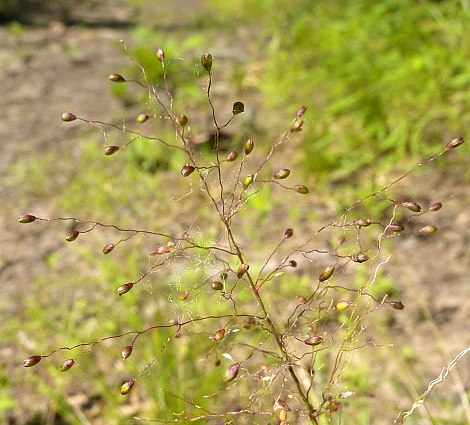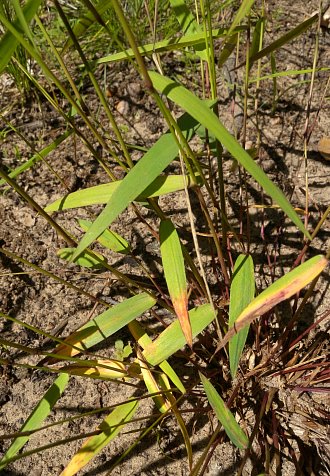
The culm terminates in an exerted panicle of spikelets about 1½-4" long and similarly across. This panicle has slender wiry branches and an airy appearance. Lateral branches alternate along the central axis of the panicle in groups of 1-3; these branches are ascending to widely spreading. The lateral branches subdivide into branchlets that terminate in one or more spikelets on short pedicels. The central axis, branches, branchlets, and pedicels are light green to purple and hairless. The one-flowered spikelets occur individually. Each spikelet is about 2 mm. in length, 1 mm. across, ovoid-obovoid in shape, and glabrous, consisting of 2 glumes, a single lemma, and a perfect floret. The smaller glume is up to one-third the length of the spikelet and ovate in shape, while the remaining glume and the lemma are about the same size as the spikelet. There are several fine veins along two sides of the spikelet. The blooming period for the vernal form of this grass can occur from late spring to mid-summer, lasting about 1 week. The florets are cross-pollinated by the wind. There is also an autumnal form of this grass that remains erect, but branches abundantly toward the middle of the main culm. The leaf blades of these lateral branches are about 1" long and 1-2 mm. across, providing the autumnal form with a bushy appearance. Sometimes secondary panicles of spikelets are produced from these lateral branches, but they are smaller in size and have fewer spikelets than the panicle of the vernal form. The grains of the spikelets are about 1.5 mm. long, ovoid in shape, slightly flattened, tan-colored, and glabrous. The root system consists of a shallow knotted crown with fibrous roots.
Cultivation: The preference is full or partial sun, mesic to dry conditions, and a somewhat acidic soil that is either sandy or rocky (e.g., derived from sandstone).

Range & Habitat: The native Forked Panic Grass is occasional in southern Illinois and uncommon or absent elsewhere within the state (see Distribution Map). Illinois lies along the northwest range limit of this species. Habitats include rocky upland woodlands, sandy upland woodlands, sandy savannas, stabilized sand dunes near Lake Michigan, sandstone glades, and swampy woodlands (the last habitat is less typical in Illinois). This grass is usually found in open wooded areas where there is some direct sunlight reaching the ground vegetation. Occasional wildfires and other kinds of disturbance are probably beneficial in maintaining populations of this species.
Faunal Associations: The caterpillars of several skippers feed on panic grasses (Dichanthelium or Panicum spp.): Hesperia sassacus (Indian Skipper), Poanes hobomok (Hobomok Skipper), Polites themistocles (Tawny-Edged Skipper), and Wallengrenia egremet (Northern Broken-Dash). In addition, the caterpillars of two moths mine the leaf blades of these grasses: Cosmopterix gemmiferella and Cycloplasis panicifoliella. Caterpillars of the first moth have been found on Forked Panic Grass specifically. Other insect feeders include the leaf beetle Chalepus bicolor, the stilt bug Jalysus spinosus, the aphid Prociphilus erigeronensis, the stink bugs Mormidea lugens and Oebalus pugnax, and such leafhoppers as Flexamia areolata, Polyamia herbida, and Polyamia rossi. The seeds of panic grasses are an important source of food to many granivorous songbirds and upland gamebirds, especially sparrows (see Bird Table for a listing of these species). The seeds are also eaten by such rodents as the House Mouse and Prairie Deer Mouse. Cottontail Rabbits occasionally browse on the foliage, as do White-Tailed Deer on the autumnal form of the foliage during the winter. Young foliage of these grasses is edible to many farm animals, including cattle, horses, and sheep.
Photographic Location: A stabilized sand dune with scattered oak trees near Lake Michigan at the Indiana Dunes State Park in NW Indiana.
Comments: The most notable characteristic of Forked Panic Grass (the typical variety) is the absence of hairs on the foliage and spikelets. Usually, grasses in this genus have hairs on some part of their foliage or spikelets. However, there is a variety of Forked Panic Grass, Dichanthelium dichotomum barbulatum, that does have some hairs on its lower nodes. The autumnal form of this latter variety also has a tendency to sprawl across the ground, unlike the more erect habit of the typical form. Forked Panic Grass can also be distinguished from similar species by the size of its spikelets (about 2 mm. in length) and the width of its leaf blades (up to 8 mm.); some panic grasses have either smaller spikelets or larger spikelets, or their leaf blades are either more narrow or more broad.